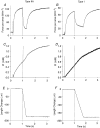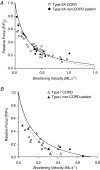Physiological properties of human diaphragm muscle fibres and the effect of chronic obstructive pulmonary disease
- PMID: 18372305
- PMCID: PMC2464347
- DOI: 10.1113/jphysiol.2007.149799
Physiological properties of human diaphragm muscle fibres and the effect of chronic obstructive pulmonary disease
Abstract
The contractile and actomyosin ATPase properties of single fibres were examined in human diaphragm muscle obtained from patients with and without chronic obstructive pulmonary disease (COPD). Costal diaphragm biopsies were taken from five patients without evidence of COPD and from 11 age-matched individuals with varying degrees of the disease. Our aim was to establish whether changes in contractile properties of COPD diaphragm could be fully explained by the previously documented shift towards a greater proportion of type I myosin heavy chain isoform in COPD. The relative proportion of type I diaphragm fibres from non-COPD and COPD patients was measured by gel electrophoresis, and was negatively correlated with FEV(1) over the full range of values investigated. There was also significant atrophy of the type I fibre population in COPD diaphragms. Isometric tension was similar among the fibre types and between the COPD and non-COPD patients. The intrinsic energetic properties of diaphragm fibres were examined by monitoring the time-resolved actomyosin ATPase activity in COPD and non-COPD fibres that produced similar isometric forces. The isometric ATPase rate in COPD fibres was reduced to 50% of the rate in non-COPD fibres; hence, the cost of isometric contraction in type I and type IIA COPD fibres was reduced to between one-third and one-half of the tension cost calculated for non-COPD fibres. The rate of force development in type I COPD fibres was reduced to 50% of the rate seen in non-COPD type-I fibres. No difference in the rate of ATP consumption between COPD and non-COPD fibres was evident during isovelocity shortening. These data extend previous findings showing that aspects of breathing mechanics during progressive COPD are associated with remodelling of the diaphragm fibre-type distribution; on top of the increase in type I fibres there are fibre-specific reductions in force development rate (type I fibres) and ATPase rate that are consistent with the impairment of cross-bridge cycling kinetics.
Figures





Similar articles
-
Bioenergetic adaptation of individual human diaphragmatic myofibers to severe COPD.J Appl Physiol (1985). 2002 Mar;92(3):1205-13. doi: 10.1152/japplphysiol.00116.2001. J Appl Physiol (1985). 2002. PMID: 11842060
-
Diaphragm dysfunction in chronic obstructive pulmonary disease.Am J Respir Crit Care Med. 2005 Jul 15;172(2):200-5. doi: 10.1164/rccm.200502-262OC. Epub 2005 Apr 22. Am J Respir Crit Care Med. 2005. PMID: 15849324 Free PMC article.
-
Glutathione and glutamate levels in the diaphragm of patients with chronic obstructive pulmonary disease.Eur Respir J. 2004 Apr;23(4):545-51. doi: 10.1183/09031936.04.00022204. Eur Respir J. 2004. PMID: 15083752
-
Respiratory muscle fibres: specialisation and plasticity.Thorax. 2004 Sep;59(9):808-17. doi: 10.1136/thx.2003.009894. Thorax. 2004. PMID: 15333861 Free PMC article. Review.
-
Diaphragm muscle fiber dysfunction in chronic obstructive pulmonary disease: toward a pathophysiological concept.Am J Respir Crit Care Med. 2007 Jun 15;175(12):1233-40. doi: 10.1164/rccm.200701-020PP. Epub 2007 Apr 5. Am J Respir Crit Care Med. 2007. PMID: 17413128 Review.
Cited by
-
Diaphragmatic dysfunction associates with dyspnoea, fatigue, and hiccup in haemodialysis patients: a cross-sectional study.Sci Rep. 2019 Dec 18;9(1):19382. doi: 10.1038/s41598-019-56035-4. Sci Rep. 2019. PMID: 31853002 Free PMC article.
-
Respiratory muscle fiber remodeling in chronic hyperinflation: dysfunction or adaptation?J Appl Physiol (1985). 2009 Jul;107(1):324-35. doi: 10.1152/japplphysiol.00173.2009. Epub 2009 Apr 9. J Appl Physiol (1985). 2009. PMID: 19359619 Free PMC article. Review.
-
Unaffected contractility of diaphragm muscle fibers in humans on mechanical ventilation.Am J Physiol Lung Cell Mol Physiol. 2014 Sep 15;307(6):L460-70. doi: 10.1152/ajplung.00076.2014. Epub 2014 Jul 18. Am J Physiol Lung Cell Mol Physiol. 2014. PMID: 25038190 Free PMC article. Clinical Trial.
-
In vivo specific tension of the human quadriceps femoris muscle.Eur J Appl Physiol. 2009 Aug;106(6):827-38. doi: 10.1007/s00421-009-1085-7. Epub 2009 May 26. Eur J Appl Physiol. 2009. PMID: 19468746
-
Physical therapy management and patient outcomes following ICU-acquired weakness: a case series.J Neurol Phys Ther. 2011 Sep;35(3):133-40. doi: 10.1097/NPT.0b013e3182275905. J Neurol Phys Ther. 2011. PMID: 21934375 Free PMC article.
References
-
- ATS/ERS. ATS/ERS Statement on respiratory muscle testing. Am J Respir Crit Care Med. 2002;166:518–624. - PubMed
-
- Barrends EM, Schols AM, Nusmeier CM, Van Der Griten CP, Wouters EF. Breathing efficiency during inspiratory threshold loading in patients with chronic obstructive pulmonary disease. Clin Physiol. 1998;18:235–244. - PubMed
-
- Curtin NA, Woledge RC. Efficiency of energy conversion during sinusoidal movement of white muscle fibres from the dogfish. Scyliorhinus canicula. J Exp Biol. 1993;183:137–147. - PubMed
Publication types
MeSH terms
Grants and funding
LinkOut - more resources
Full Text Sources
Medical

